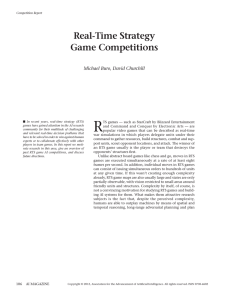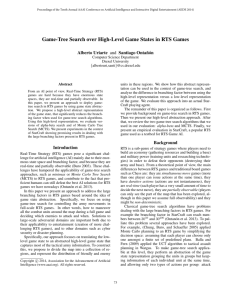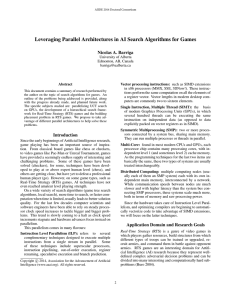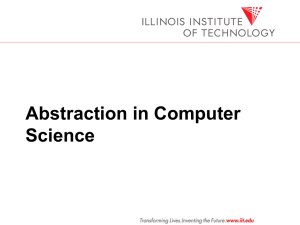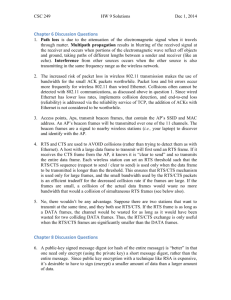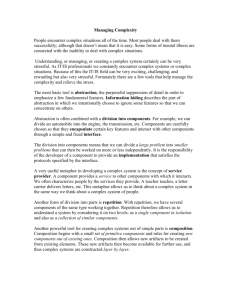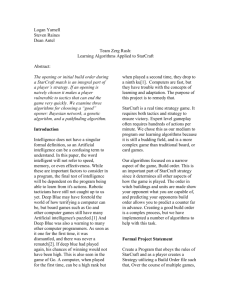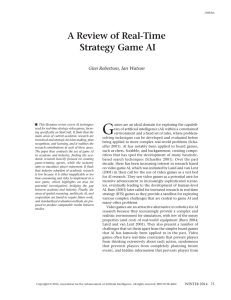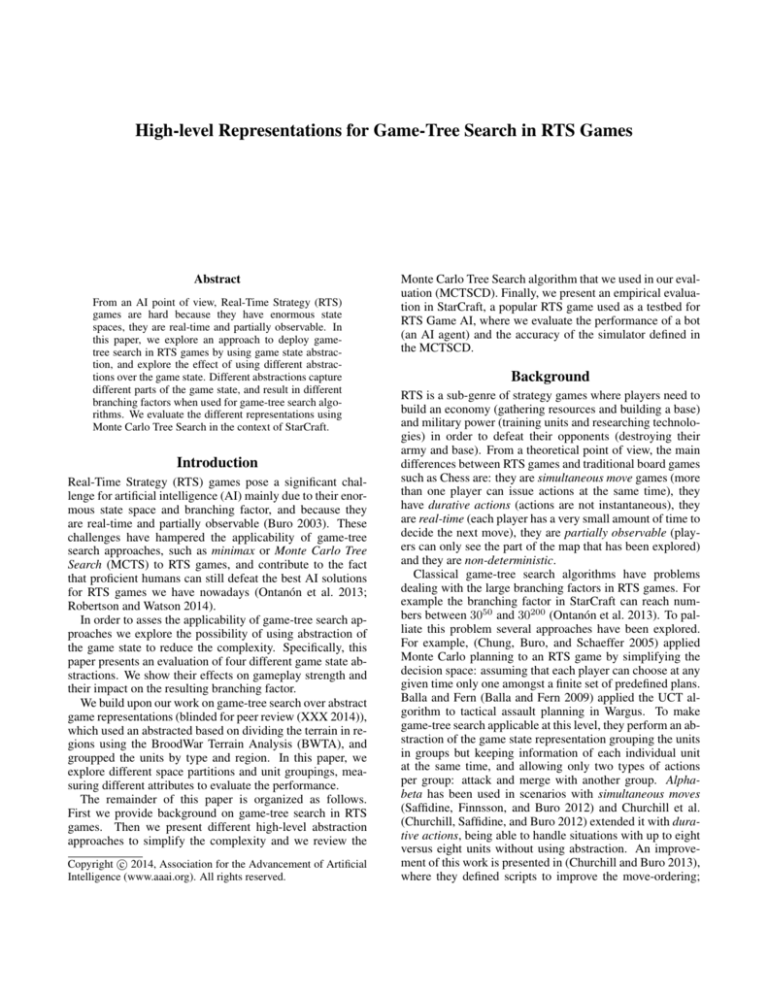
High-level Representations for Game-Tree Search in RTS Games
Abstract
From an AI point of view, Real-Time Strategy (RTS)
games are hard because they have enormous state
spaces, they are real-time and partially observable. In
this paper, we explore an approach to deploy gametree search in RTS games by using game state abstraction, and explore the effect of using different abstractions over the game state. Different abstractions capture
different parts of the game state, and result in different
branching factors when used for game-tree search algorithms. We evaluate the different representations using
Monte Carlo Tree Search in the context of StarCraft.
Introduction
Real-Time Strategy (RTS) games pose a significant challenge for artificial intelligence (AI) mainly due to their enormous state space and branching factor, and because they
are real-time and partially observable (Buro 2003). These
challenges have hampered the applicability of game-tree
search approaches, such as minimax or Monte Carlo Tree
Search (MCTS) to RTS games, and contribute to the fact
that proficient humans can still defeat the best AI solutions
for RTS games we have nowadays (Ontanón et al. 2013;
Robertson and Watson 2014).
In order to asses the applicability of game-tree search approaches we explore the possibility of using abstraction of
the game state to reduce the complexity. Specifically, this
paper presents an evaluation of four different game state abstractions. We show their effects on gameplay strength and
their impact on the resulting branching factor.
We build upon our work on game-tree search over abstract
game representations (blinded for peer review (XXX 2014)),
which used an abstracted based on dividing the terrain in regions using the BroodWar Terrain Analysis (BWTA), and
groupped the units by type and region. In this paper, we
explore different space partitions and unit groupings, measuring different attributes to evaluate the performance.
The remainder of this paper is organized as follows.
First we provide background on game-tree search in RTS
games. Then we present different high-level abstraction
approaches to simplify the complexity and we review the
c 2014, Association for the Advancement of Artificial
Copyright Intelligence (www.aaai.org). All rights reserved.
Monte Carlo Tree Search algorithm that we used in our evaluation (MCTSCD). Finally, we present an empirical evaluation in StarCraft, a popular RTS game used as a testbed for
RTS Game AI, where we evaluate the performance of a bot
(an AI agent) and the accuracy of the simulator defined in
the MCTSCD.
Background
RTS is a sub-genre of strategy games where players need to
build an economy (gathering resources and building a base)
and military power (training units and researching technologies) in order to defeat their opponents (destroying their
army and base). From a theoretical point of view, the main
differences between RTS games and traditional board games
such as Chess are: they are simultaneous move games (more
than one player can issue actions at the same time), they
have durative actions (actions are not instantaneous), they
are real-time (each player has a very small amount of time to
decide the next move), they are partially observable (players can only see the part of the map that has been explored)
and they are non-deterministic.
Classical game-tree search algorithms have problems
dealing with the large branching factors in RTS games. For
example the branching factor in StarCraft can reach numbers between 3050 and 30200 (Ontanón et al. 2013). To palliate this problem several approaches have been explored.
For example, (Chung, Buro, and Schaeffer 2005) applied
Monte Carlo planning to an RTS game by simplifying the
decision space: assuming that each player can choose at any
given time only one amongst a finite set of predefined plans.
Balla and Fern (Balla and Fern 2009) applied the UCT algorithm to tactical assault planning in Wargus. To make
game-tree search applicable at this level, they perform an abstraction of the game state representation grouping the units
in groups but keeping information of each individual unit
at the same time, and allowing only two types of actions
per group: attack and merge with another group. Alphabeta has been used in scenarios with simultaneous moves
(Saffidine, Finnsson, and Buro 2012) and Churchill et al.
(Churchill, Saffidine, and Buro 2012) extended it with durative actions, being able to handle situations with up to eight
versus eight units without using abstraction. An improvement of this work is presented in (Churchill and Buro 2013),
where they defined scripts to improve the move-ordering;
and experiments with UCT considering durations and a Portfolio Greedy Search; showing good results in larger combat
scenarios than before. Ontañón (Ontañón 2013) presented a
MCTS algorithm called Naı̈veMCTS specifically designed
for RTS games, and showed it could handle full-game, but
small scale RTS game scenarios. Some work has been done
also using Genetic Algorithms and High Climbing methods
(Liu, Louis, and Nicolescu 2013) or Reinforcement Learning (Jaidee and Muñoz-Avila 2012).
High-level Abstraction in RTS Games
The key idea of the different state abstractions explored in
this paper is to first simplify the game map by dividing it in a
set of regions. Specifically, as in our previous work (blinded
for peer review (XXX 2014)), we used Perkins algorithm
(Perkins 2010), implemented in the BWTA library, for this
purpose. Since the map is invariant through all the game
we only need to compute this once. With this region decomposition now the combat units (and the main bases) are
grouped by unit type and region. For each group we capture
the following information: Player (which player controls
this group), Type (type of units in this group), Size (number of units forming this group.), Region (which region is
this group in), Order (which order is this group currently
performing), Target (the ID of the target region) and End (In
which game frame is the order estimated to finish).
Based on this idea, we propose four different abstractions:
• A-RC: This is our baseline abstraction, and corresponds
to the one used in our previous work (blinded for peer
review (XXX 2014)). Similar to the abstraction proposed
by Synnaeve (Synnaeve and Bessière 2012), in addition to
the regions returned by Perkins’ algorithm. We add one
additional region for each chokepoint in the map (with
center at the center of the chokepoint, and a circular area
of the same diameter as the chokepoint). We only consider military units in this abstraction, although for the
specific case of StarCraft, we also add the main bases
(Terran Command Centers, etc.), since it is necessary for
the AI to know where to send units to attack.
• A-RCB: Same as A-RC, but we also add all the buildings
in the game.
• A-R: Like A-RC, but without having additional regions
for chokepoints. In this way we have a simpler high-level
map representation. To evaluate the impact of these simplification we computed the number of nodes, the average
connectivity and the diameter of the generated graph are
shown in Table 1.
• A-RB: Like A-R, but also adding all the buildings in the
game.
We define the following set of possible actions for each
high-level group: N/A, Move, Attack and Idle:
• N/A: only for buildings as they cannot perform any action,
• Move: move to an adjacent region,
• Attack: attack any enemy in the current region, and
• Idle: do nothing during 400 frames.
Figure 1: Snapshot of a StarCraft game.
A-RC
A-RCB
1
1
2
2
3
3
A-R
A-RB
1
1
3
3
Figure 2: Representation of a game state using different
high-level abstraction with the ID of each region.
Figure 1 shows a portion of a real game state of a StarCraft game. And in Figure 2 we graphically illustrate the
different high-level abstractions defined previously using the
game state from Figure 1. The actual internal representation of the high-level game state is simply a matrix with one
row per unit type × region, where in each row we store the
number of units of that type, and the action they are currently executing. Table 1 shows, for a few StarCraft maps,
the number of regions in which each map is divided, the average connectivity of each region, and the diameter of the
resulting graph.
High-Level Game-Tree Search
To evaluate the proposed high-level game state abstraction,
we decided to use the game-tree search algorithm MCTSCD
(blinded for peer review (XXX 2014)). MCTSCD is a variant of Monte Carlo Tree Search algorithm that can handle
simultaneous moves and durative actions (features present
in all RTS games). To be able to perform any MCTS algorithm we need to define two components. The first one is
a state forwarding function that can roll the game forward
using the high-level game state representation, and the second one is the state evaluation function. We used the ones
defined by MCTSCD authors, where:
• The state forwarding first try to predict in which game
frame the action of each group will be finished. To do this
we use the group velocity and the distance between regions to predict movements. And the Damage Per Frame
Table 1: Statistics of different StarCraft maps and map abstractions.
Map
Abs.
Size
(2)Benzene
(2)Benzene
(2)Destination
(2)Destination
(2)Heartbreak Ridge
(2)Heartbreak Ridge
(3)Aztec
(3)Aztec
(3)Tau Cross
(3)Tau Cross
(4)Python
(4)Python
(4)Fortress
(4)Fortress
(4)Empire of the Sun
(4)Empire of the Sun
(4)Andromeda
(4)Andromeda
(4)Circuit Breaker
(4)Circuit Breaker
RC
R
RC
R
RC
R
RC
R
RC
R
RC
R
RC
R
RC
R
RC
R
RC
R
59
37
65
40
68
43
70
46
58
38
33
23
29
21
105
67
81
55
93
59
Avg.
Connect.
1.492
1.189
1.538
1.250
1.471
1.163
1.371
1.043
1.379
1.053
1.212
0.870
1.103
0.762
1.448
1.134
1.284
0.945
1.462
1.153
Diam.
8
16
8
16
9
18
6
12
6
12
4
8
4
8
9
18
10
20
6
12
(DPF) of each group in the region in conflict to predict the
output of a combat. Then we identify the action with the
smallest end time and forward the game time to that moment. Notice that we do not implement any kind of merge
operation, i.e. if two groups of the same unit type meet in
the same region, we do not merge both groups. We consider that since both groups have different “timing” one
of them will perform actions faster than the other.
• To compute the state evaluation we use the destroy score
of a unit. So, given a set of high-level friendly groups
F of size n and a set of high-level enemy groups E
of size m, we calculate the following
reward: score =
P
Pm
n
0 (Fi .size × killScore) −
0 (Ej .size × killScore),
where the killScore is a score that StarCraft internally assigns to each unit.
Experimental Evaluation
In order to compare the performance of the different abstractions, we used the RTS game StarCraft. We incorporated
our abstraction layer into a StarCraft bot (blinded for peer
review (XXX 2012)) and evaluated the performance using
MCTSCD to command our army during a real game. The
following subsections present our experimental setup and
the results of our experiments.
Experimental Setup
Dealing with partial observability, due the fog of war in StarCraft is out of scope in this paper, and is part of our future work. Therefore we disable the fog of war in order to
have perfect information of the game. We also limited the
Table 2: Results of MCTSCD using different high-level
game state representations and a scripted AI.
Algorithm
Scripted
MCTSCD-RC
MCTSCD-RCB
MCTSCD-R
MCTSCD-RB
Avg. Kill Score ∆
9171.25
2562.50
2183.75
4796.25
5051.25
%>0
100.00
97.50
87.50
97.50
97.50
length of a game to avoid situations where our bot is unable to win because it cannot find all the opponent’s units
(StarCraft ends when all the opponent units are destroyed).
In the StarCraft AI competition the average game length is
about 21,600 frames (15 minutes), and usually the resources
of the initial base are gone after 26,000 frames (18 minutes). Therefore, we decided to limit the games to 20 minutes (28,800 frames). If we reach the timeout we evaluate
the current game state using the evaluation function to decide who won the game.
In our experiments, we call MCTSCD to perform highlevel search once every 400 frames (16,6 seconds of real
gameplay). Taking into account that the minimum training
time for a unit is 300 frames, this gives a confidence margin
to reevaluate our decision with the new units in the game
state. For experimentation purposes, we pause the game
while the search is taking place. As part of our future work,
we want to explore splitting the search along several game
frames, instead of pausing the game.
For MCTSCD we use a -greedy tree policy with =
0.2, a random move selection for the default policy and
an Alt policy (Churchill, Saffidine, and Buro 2012) to decide which player will play first in a simultaneous node.
We also limit the depth of the tree policy to 10, and run
MCTSCD for 1,000 playouts with a length of 2,880 game
frames (120 seconds of real gameplay). We experimented
with 4 different high-level abstract representations as we explained in previous sections, leading to the following configurations: MCTSCD-RC, MCTSCD-RCB, MCTSCD-R and
MCTSCD-RB.
We used the Benzene StarCraft map for our evaluation
and run 40 games with our bot playing the Terran race
against the built-in Terran AI of StarCraft. We compare the
results against a highly optimized scripted version (which
has participated in the StarCraft AI competition).
Moreover, we performed two sets of experiments (explained in the following two sections). In the first, we evaluate the performance of our bot, when using each of the four
abstract representations. In the second, we evaluated how
accurate are the simulations used internally by the search
algorithm (to roll the state forward) using each of the four
abstract representations (i.e., which of the representations
result in a game tree that is a more accurate representation
of the actual game?).
Bot Performance Evaluation
Table 2 shows the results we obtained with each configuration. The column labeled as Avg. Kill Score ∆ shows
Table 3: Similarity between the predicted game state and the
current game state.
Similarity
0.573152
0.768658
0.688179
0.818043
the average value of the difference on the kill score of each
player at the end of the game. The kill score is a score
that StarCraft maintains, based on how many enemy units
each player manages to kill during the game, and on specific scores assigned to each unit. The column labeled as %
> 0 shows the percentage of games where the Kill Score
∆ was positive (i.e., our bot achieved a higher kill score
than the opponent). As a reference point we compare the
results against a highly optimized scripted version of the
bot showing that the scripted version still achieves a higher
win ratio. The results reveal two important facts. First,
although the win ratio adding chokepoints or not is similar (MCTSCD-RC vs MCTSCD-R), without including the
chokepoints (MCTSCD-R) we achieve a better average kill
score ∆, meaning that we were winning with a better margin. The second fact is the poor performance when we consider all the buildings (MCTSCD-RCB) ending in losing
more games. But if we look at the MCTSCD-RB, it is better
than the other high-level abstraction. Our hypothesis is that
including chokepoints in the game state creates confusion
that is carried over when buildings are included.
Simulation Accuracy Evaluation
In order to gain more insight into the experiments, in
this section we evaluate the accuracy of the simulator being used in the roll-out step of the MCTSCD. To evaluate this we defined a similarity measure between game
states, based on the Jaccard similarity coefficient. We use
HLGMt to denote the similarity between the actual highlevel state at time t, with the high-level state at time t
that resulted from simulation, given the actions selected
by MCTSCD to reach time t. More formally we use the
method Simulate(GameState, Orders, F rames) where
GameState is a high-level game state, orders is the orders
to execute each unit, and frames the amount of frames to forward the high-level game state. So, we execute the method
with the following arguments:
HLGM Sim = Simulate(HLGMx−400 , Orders, 400)
Then we can use Equation 1 to compute the Jaccard index.
J(HLGM, HLGM Sim) =
|HLGM ∩ HLGM Sim|
|HLGM ∪ HLGM Sim|
(1)
This Jaccard index helps us to see how accurate is our simulator, in Table 3 we can observe how the map abstraction
with region and chokepoints (MCTSCD-RC) has the worst
A-R
A-RB
1
Jaccard index
Algorithm
MCTSCD-RC
MCTSCD-RCB
MCTSCD-R
MCTSCD-RB
A-RC
A-RCB
0.9
0.8
0.7
0.6
0.5
0.4
5
10
15
20
25
30
35
40
45
Number of Groups
Figure 3: Average Jaccard index grouped by the number of
groups in the high-level state.
similarity, in other words, the simulator make less accurate
predictions of unit positions. As expected, we get the bests
results when we add all the building in our high-level representation (MCTSCD-RCB and MCTSCD-RB) since buildings are easy to predict due their lack of movement. But the
remarkable part is that the simpler map abstraction only considering regions (MCTSCD-R) has better predictions than
the baseline (MCTSCD-RC). That also explains why we get
better average evaluation scores with this simpler abstraction.
To get further insights into the similarity we analyzed the
Jaccard index by group size. As we can see on Figure 3,
adding the chokepoints to our map abstraction deteriorates
our ratio to have an accurate prediction. The reader has to
keep in mind that this similarity coefficient is only computed
with the prediction after 400 frames when in the MCTSCD
we simulate until reach 2,880 frames. Therefore the error
between the actual game state and the predicted game state
at the end of a playout of length 2,880 could be even larger.
Conclusions
This paper has presented our experiments on different ways
to reduce the search complexity using abstractions of the
game state. We also present a methodology to evaluate the
accuracy of the simulator inside MCTS for RTS games. Our
experimental results indicate that it is better to keep the abstraction simple in order to get better predictions (and therefore better performance of our agent). So, for the map
abstraction chokepoints are not needed to capture all the
needed detail for our high-level abstraction, while we can
afford the inclusion of all the buildings for a better search.
As part of our future work, we would like to improve the
game tree search algorithm (for example, exploring different
bandit strategies for MCTS or to be able to deal with partial
observability). Additionally, we would like to continue exploring abstractions and their tradeoffs. Finally, we would
also like to improve our game simulator to learn during the
course of a game, and produce more accurate combat estimations, independently of the RTS game being used.
References
Balla, R.-K., and Fern, A. 2009. UCT for tactical assault
planning in real-time strategy games. In International Joint
Conference of Artificial Intelligence, IJCAI, 40–45. San
Francisco, CA, USA: Morgan Kaufmann Publishers Inc.
Buro, M. 2003. Real-time strategy games: a new AI research
challenge. In Proceedings of IJCAI 2003, 1534–1535. San
Francisco, CA, USA: Morgan Kaufmann Publishers Inc.
Chung, M.; Buro, M.; and Schaeffer, J. 2005. Monte Carlo
Planning in RTS Games. In IEEE Symposium on Computational Intelligence and Games (CIG).
Churchill, D., and Buro, M. 2013. Portfolio Greedy search
and Simulation for Large-Scale Combat in StarCraft. In
CIG. IEEE.
Churchill, D.; Saffidine, A.; and Buro, M. 2012. Fast
Heuristic Search for RTS Game Combat Scenarios. In AIIDE.
Jaidee, U., and Muñoz-Avila, H. 2012. CLASSQ-L: A
Q-Learning Algorithm for Adversarial Real-Time Strategy
Games. In AIIDE.
Liu, S.; Louis, S. J.; and Nicolescu, M. N. 2013. Comparing heuristic search methods for finding effective group
behaviors in RTS game. In IEEE Congress on Evolutionary
Computation. IEEE.
Ontañón, S. 2013. The combinatorial multi-armed bandit
problem and its application to real-time strategy games. In
AIIDE 2013, 58–64.
Ontanón, S.; Synnaeve, G.; Uriarte, A.; Richoux, F.;
Churchill, D.; and Preuss, M. 2013. A Survey of Real-Time
Strategy Game AI Research and Competition in StarCraft.
IEEE Transactions on Computational Intelligence and AI in
Games (TCIAIG) 5:1–19.
Perkins, L. 2010. Terrain Analysis in Real-Time Strategy
Games: An Integrated Approach to Choke Point Detection
and Region Decomposition. In AIIDE, 168–173.
Robertson, G., and Watson, I. 2014. A Review of Real-Time
Strategy Game AI. AI Magazine.
Saffidine, A.; Finnsson, H.; and Buro, M. 2012. Alpha-Beta
Pruning for Games with Simultaneous Moves. In 26th AAAI
Conference (AAAI). Toronto, Canada: AAAI Press.
Synnaeve, G., and Bessière, P. 2012. A Bayesian Tactician.
In Computer Games Workshop at ECAI.
XXX. 2012. Yyy. In ZZZ.
XXX. 2014. Yyy. In ZZZ.



